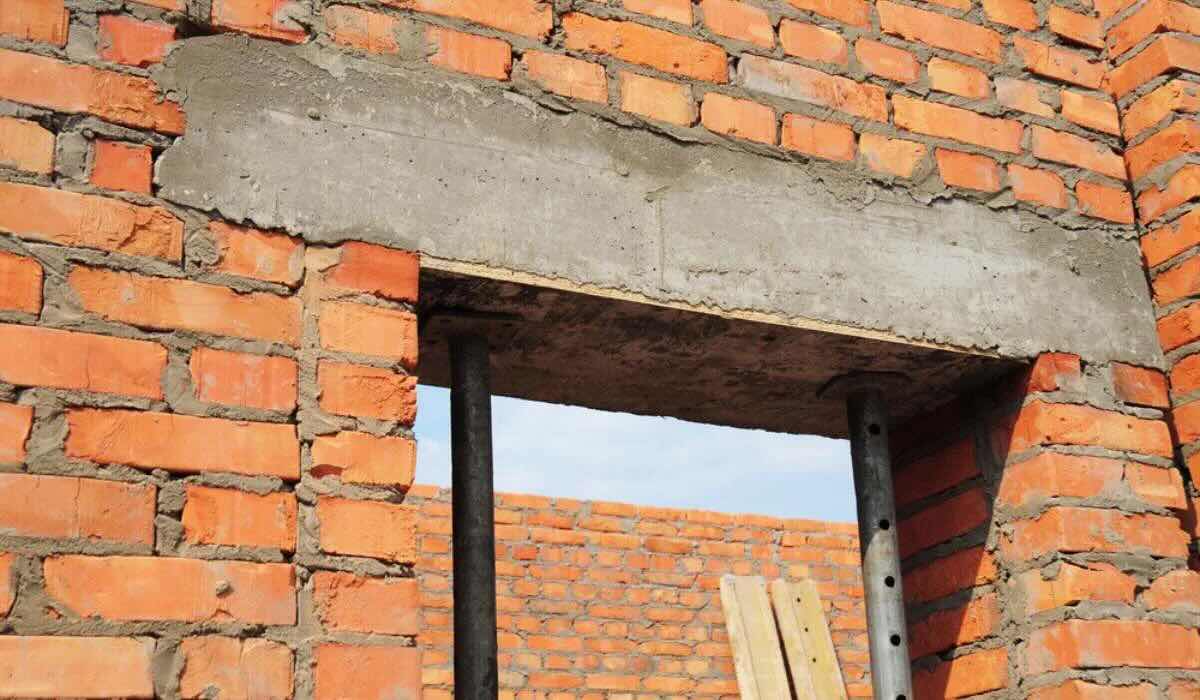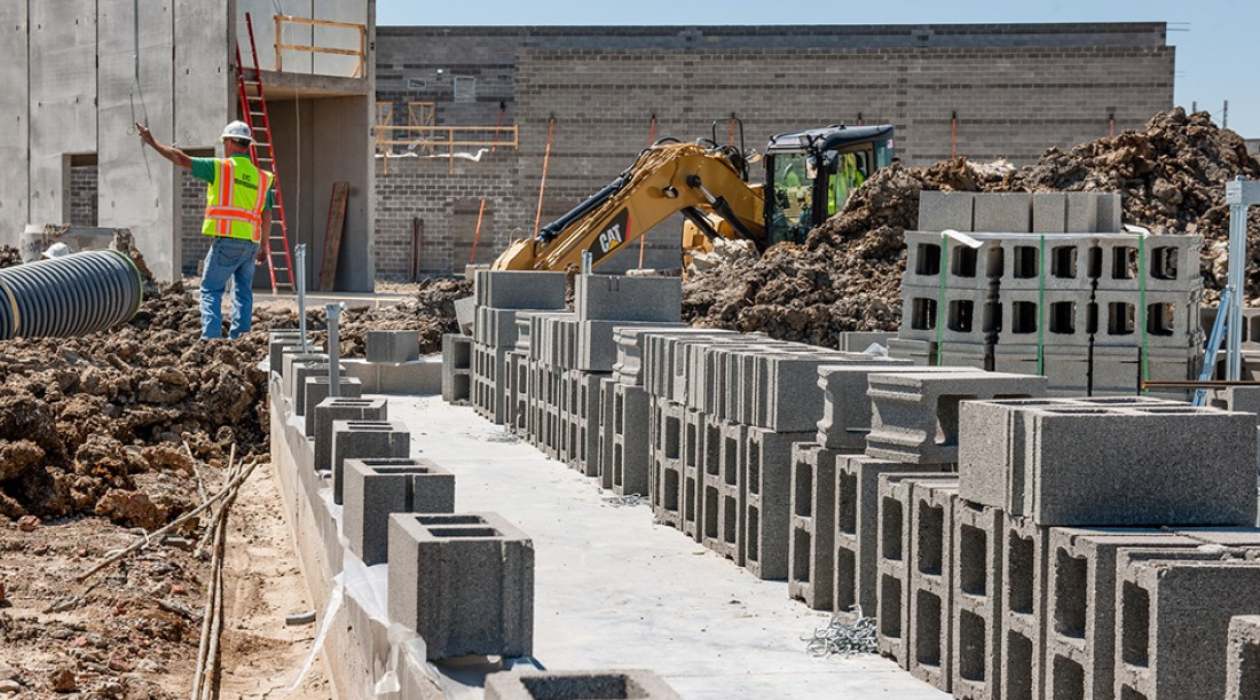Home>diy>Building & Construction>What Are Lintels In Construction


Building & Construction
What Are Lintels In Construction
Modified: May 6, 2024
Discover the importance of lintels in building construction. Learn how lintels support loads and distribute weight in structures for long-lasting stability.
(Many of the links in this article redirect to a specific reviewed product. Your purchase of these products through affiliate links helps to generate commission for Storables.com, at no extra cost. Learn more)
Introduction
When it comes to building construction, one of the key elements that often goes unnoticed but plays a crucial role in providing strength and support is the lintel. Lintels are an essential part of any structure, serving as horizontal supports over openings such as windows, doors, and archways. These critical components distribute the weight of the structure above, ensuring the integrity and stability of the building.
In simple terms, lintels are like sturdy beams that span the gap between two vertical supports, transferring the load from the area above to the surrounding walls or columns. They act as a structural bridge, preventing any sagging or collapse that could occur due to the weight of the materials above the opening.
Lintels are usually made of durable materials such as concrete, steel, or timber, depending on the specific requirements of the project. Their design and dimensions will vary based on factors such as the width and height of the opening, the load it needs to support, and the aesthetic requirements of the structure.
Understanding the significance of lintels in construction and the various types available is crucial for architects, builders, and even homeowners. By incorporating high-quality lintels into their construction projects, they can ensure the stability and longevity of the structure. Additionally, the correct installation and regular maintenance of lintels are essential to prevent any structural issues in the future.
In this article, we will delve deeper into the world of lintels, exploring their definition, materials used, different types, benefits, installation process, and maintenance tips. Whether you are involved in the construction industry or simply curious about the hidden elements that make buildings strong and reliable, this article will provide you with a comprehensive understanding of lintels and their importance in construction.
Key Takeaways:
- Lintels are crucial structural components in construction, providing essential support and stability to buildings by distributing weight over openings. They offer design flexibility, load-bearing capacity, and fire resistance, contributing to the longevity and safety of structures.
- Proper installation and regular maintenance of lintels are vital for ensuring their functionality and integrity. Visual inspections, cleaning, repointing, and addressing issues promptly are essential maintenance measures to protect the long-term stability of buildings.
Definition of Lintels
Lintels are horizontal structural components that are placed over openings in buildings, such as windows, doors, and archways, to support the weight of the structure above. They are designed to distribute the load evenly to the surrounding walls or columns and provide stability and strength to the building.
Lintels serve as a bridge between the two vertical supports, ensuring that the load is transferred efficiently and preventing any sagging or collapse. They are typically positioned at the top of the opening, spanning the gap and bearing the weight of the materials above. By offering support to the structure, lintels contribute significantly to the overall structural integrity of the building.
These essential components are available in various sizes and designs to accommodate different types of openings and loads. The choice of lintel depends on factors such as the width and height of the opening, the material used, and the load requirements of the structure.
Lintels can be made from a range of materials, including concrete, steel, and timber. Each material has its pros and cons, and the selection depends on factors such as cost, strength, durability, and aesthetic considerations.
In summary, lintels are horizontal structural elements that provide crucial support and stability to buildings by spanning openings and distributing the load. These versatile components are available in different materials and designs, ensuring their suitability for a wide range of construction projects. By incorporating lintels into the building design, architects and builders can ensure the integrity and longevity of the structure.
Materials Used for Lintels
Lintels are fabricated using various materials, each with its unique characteristics and advantages. The choice of material depends on factors such as the load requirements, aesthetic preferences, budget constraints, and the specific needs of the construction project. Let’s explore the common materials used for lintels:
1. Concrete:
Concrete lintels are widely used in construction due to their durability and cost-effectiveness. They are made by pouring concrete into molds and allowing it to set and cure. Concrete lintels can be precast or cast in place, depending on the project requirements. They offer excellent load-bearing capacity and are suitable for long spans and heavy loads.
2. Steel:
Steel lintels are popular for their high strength and versatility. They are typically made from structural steel, such as I-beams or channels, which can withstand heavy loads. Steel lintels are available in various shapes and sizes to accommodate different opening dimensions. They are known for their durability, resistance to corrosion, and ability to span large distances without the need for additional supports.
3. Timber:
Timber lintels, often made from hardwood or engineered wood materials, offer a natural and aesthetically pleasing option. They are suitable for smaller openings or light loads. Timber lintels are lightweight, easy to handle, and can be customized to fit specific design requirements. However, they may require regular maintenance to protect against moisture, insect damage, and decay.
4. Limestone and Stone:
Limestone and stone lintels provide a traditional and visually appealing option for lintel construction. These materials are natural and can be cut and shaped to match the opening dimensions. Limestone and stone lintels are commonly used in historical buildings or projects where a specific architectural style is desired. They may require additional supports or reinforcement to handle heavier loads.
5. Composite Materials:
With advancements in construction technology, composite materials are also being used for lintel fabrication. These materials are a combination of two or more substances, such as concrete and steel, to maximize strength and durability while minimizing weight and cost.
It is important to consult with architects and structural engineers to determine the most suitable material for lintels based on the specific project requirements. Factors such as load capacity, design preferences, budget, and local building codes all play a role in selecting the ideal material for lintel construction.
By selecting the appropriate material for lintels, builders can ensure the longevity, stability, and aesthetic appeal of the structure.
Types of Lintels
Lintels come in various types, each designed to suit specific construction needs and architectural styles. The choice of lintel type depends on factors such as the load requirements, opening dimensions, material availability, and aesthetic considerations. Here are some of the common types of lintels:
Read more: What Is Pre-Construction In Construction
1. Plain Lintels:
Plain lintels are simple, rectangular-shaped lintels that provide basic support and span across openings. They are usually made of materials like concrete, steel, or timber, and are suitable for standard openings with moderate loads. Plain lintels are cost-effective and widely used in residential and commercial construction projects.
2. Reinforced Lintels:
Reinforced lintels are designed with additional reinforcement to handle heavier loads or wider spans. These lintels may incorporate steel bars, mesh, or rods embedded within the material to enhance their strength. Reinforced lintels are commonly used in areas where the load-bearing capacity needs to be increased, such as in large openings or in structures with multiple floors.
3. Precast Lintels:
Precast lintels are manufactured off-site and then transported to the construction site for installation. They are produced in controlled factory conditions, ensuring consistent quality and dimensional accuracy. Precast lintels are available in various shapes and sizes and are often made of concrete. They offer ease of installation and can be customized to meet specific project requirements.
4. Arched Lintels:
Arched lintels are curved or rounded lintels that provide an aesthetically pleasing alternative to traditional straight lintels. They are commonly used in architectural designs where an arched opening or feature is desired. Arched lintels can be made of materials like stone, concrete, or steel and require careful engineering to ensure the structural integrity of the arch.
Read more: What Is Construction
5. Discontinuous or Segmental Lintels:
Discontinuous or segmental lintels are designed with breaks or cutouts along their length. These cutouts help with reducing the weight of the lintel itself and add architectural interest to the structure. Discontinuous lintels can be made from various materials and are often used in projects where design creativity and visual appeal are important.
It is important to consult with architects, engineers, and building professionals to determine the most suitable type of lintel for a particular construction project. Factors such as load-bearing requirements, design preferences, and structural considerations all contribute to selecting the appropriate lintel type. By choosing the right lintel type, builders can ensure the structural integrity, aesthetics, and functionality of the building.
Benefits of Using Lintels in Construction
Lintels play a crucial role in the construction industry, offering a multitude of benefits that contribute to the overall integrity and functionality of a building. Here are some of the key advantages of using lintels in construction:
1. Structural Support:
Lintels provide essential structural support by distributing the weight of the building above openings such as windows, doors, and archways. By transferring the load to the surrounding walls or columns, lintels help prevent sagging or collapsing, ensuring the stability and durability of the structure.
2. Load-Bearing Capacity:
Lintels are designed to bear heavy loads and span across large openings. They are engineered to support the weight of materials such as masonry, brickwork, or stone above the openings. Lintels with appropriate load-bearing capacity ensure that the structure remains sturdy and can withstand external forces.
Read more: What Is An MEP In Construction
3. Design Flexibility:
Lintels come in various shapes, sizes, and materials, offering architects and builders design flexibility. This allows for customization to suit different architectural styles and aesthetic preferences. Whether it’s a plain lintel for a minimalist design or an arched lintel for a more ornate look, lintels provide options to enhance the visual appeal of the structure.
4. Versatility:
Lintels can be used in a wide range of construction projects, from residential homes to commercial buildings and even historical restorations. They are adaptable to different building materials and construction methods, making them a versatile choice for various construction applications.
5. Time and Cost Efficiency:
Using lintels in construction can help streamline the building process, saving time and reducing costs. Lintels are pre-engineered components designed for specific load requirements, making them easy to install. Additionally, precast lintels can be manufactured off-site, ready for quick installation, which helps streamline the construction schedule.
6. Longevity:
Lintels are made from durable materials such as concrete, steel, or timber, ensuring their longevity. They are resistant to decay, insect damage, and other environmental factors. Properly maintained lintels can ensure the long-term stability and strength of the building.
Read more: What Is GMP Construction
7. Fire Resistance:
Lintels made from fire-resistant materials such as concrete or steel provide added fire protection to the structure. In the event of a fire, these lintels can help prevent the spread of flames and protect the integrity of the building, allowing occupants more time to evacuate safely.
By incorporating lintels into construction projects, architects, builders, and homeowners can benefit from the structural support, design flexibility, and cost efficiency that these essential components provide. With their load-bearing capacity and versatile nature, lintels play a crucial role in creating safe, functional, and visually appealing buildings.
Installation of Lintels
The installation of lintels is a critical part of the construction process, as it ensures the proper support and distribution of weight over openings. Here are the general steps involved in the installation of lintels:
1. Planning:
Prior to installation, thorough planning is essential to determine the correct size, material, and type of lintel required for each opening. Factors such as the load requirements, span, wall construction, and architectural design need to be taken into consideration during this phase.
2. Obtaining the Lintels:
Once the planning is complete, the appropriate lintels need to be sourced. These can be purchased from building supply stores or precast manufacturers. It is important to ensure that the lintels meet the specified requirements and comply with local building codes and regulations.
Read more: What Is A Construction Agreement
3. Preparation and Support:
Before installing the lintel, the opening must be prepared. This involves removing any existing materials, such as bricks or blocks, and ensuring that the walls are clean and level. Adequate temporary supports should be in place to hold the load while the lintel is being installed.
4. Lintel Placement:
The lintel is carefully positioned over the opening, ensuring that it is level and properly aligned. If necessary, shims or adjustable supports can be used to achieve the correct placement. It is important to follow the manufacturer’s instructions and any design specifications during this step.
5. Fixing and Anchoring:
The lintel is then fixed in place, typically by using mortar or construction adhesive. The ends of the lintel should be securely anchored to the surrounding wall or columns to provide stability and to prevent any movement. Additional reinforcement may be required for larger or heavier lintels.
6. Grouting and Finishing:
Once the lintel is securely in place, the gaps between the lintel and the surrounding wall should be filled with grout or mortar to ensure a solid connection. This helps to distribute the load evenly and provides a finished look. Any excess material should be cleaned up, and the lintel should be inspected for levelness and alignment.
Read more: What Is A House Construction
7. Post-Installation Checks:
After the completion of the lintel installation, it is important to conduct thorough checks to ensure that everything is functioning as intended. This may involve inspecting for any signs of cracking, testing the stability and load-bearing capacity, and verifying that the lintel meets the required specifications and building codes.
It is essential to consult with experienced professionals, such as structural engineers or licensed contractors, to ensure the correct installation of lintels. Proper installation plays a crucial role in the structural integrity and safety of the building, making it a task that should be carried out with accuracy and attention to detail.
Maintenance of Lintels
Maintaining lintels is essential to ensure their long-term functionality, structural integrity, and to prevent any potential issues. Regular maintenance can help identify and address any signs of damage or deterioration. Here are some key measures for the maintenance of lintels:
1. Visual Inspection:
Regularly visually inspect lintels for any visible signs of damage, such as cracks, corrosion, or crumbling mortar. Pay attention to any sagging or deflection in the lintel or surrounding structure. Look for signs of water leakage or moisture, as this can indicate potential issues that need to be addressed.
2. Cleaning:
Lintels should be kept clean of debris, dirt, and vegetation growth. Regular cleaning using a soft brush or cloth can help prevent the accumulation of dirt and moisture. Avoid using harsh chemicals or abrasive materials that could damage the surface of the lintel material.
Read more: What Are Joists In Construction
3. Repointing and Sealing:
If there are any signs of mortar deterioration or cracking, it is important to have the lintel repointed. Repointing involves removing damaged mortar joints and replacing them with new mortar. Additionally, consider sealing the lintel with an appropriate sealant to protect it from moisture penetration and reduce the risk of deterioration.
4. Corrosion Prevention:
If the lintel is made of steel, take measures to prevent corrosion. Regularly inspect the lintel for any signs of rusting and treat it with an appropriate anti-corrosion paint or coating. This helps to protect the steel from moisture, preventing rust formation and potential structural damage.
5. Professional Inspection:
At regular intervals, consider engaging professional building inspectors or structural engineers to conduct a comprehensive assessment of the lintels. They can identify any underlying issues, assess the load-bearing capacity, and recommend any necessary maintenance or repairs.
6. Addressing Issues Promptly:
If any signs of damage or deterioration are found during routine inspections or maintenance, address them promptly. Ignoring or delaying repairs can lead to further structural damage and compromise the integrity of the building. Engage qualified professionals to carry out the necessary repairs or reinforcement work.
Read more: What Is Surety In Construction
7. Compliance with Building Codes:
When conducting maintenance or repairs, ensure that all work complies with local building codes and regulations. This helps to ensure the safety and longevity of the structure, and it may be required for insurance or legal purposes.
By implementing a regular maintenance routine and addressing any issues promptly, lintels can be kept in optimal condition, ensuring the long-term stability and functionality of the building. Regular inspections and maintenance not only contribute to the safety of the structure but also help to identify potential problems before they become more extensive and costly to repair.
Conclusion
Lintels are a fundamental component in building construction, providing essential support and stability to structures. They distribute the weight of the building above openings, such as windows, doors, and archways, ensuring the integrity and longevity of the overall structure.
By understanding the definition, materials used, types, benefits, installation process, and maintenance requirements of lintels, architects, builders, and homeowners can make informed decisions in their construction projects. Lintels come in various materials, such as concrete, steel, timber, or stone, offering versatility and design flexibility to suit different architectural styles and load requirements.
The benefits of using lintels in construction are numerous. They provide structural support, handle heavy loads, offer design flexibility, and are time and cost-efficient. Lintels also contribute to the longevity of buildings by protecting against fire, decay, and insect damage. However, proper installation and regular maintenance are crucial to ensure their continued functionality and integrity.
When it comes to the installation of lintels, careful planning, proper support, and accurate placement are essential. Adhering to manufacturer guidelines and following best practices during the installation process is crucial for ensuring the stability and load-bearing capacity of the lintels.
Maintenance of lintels involves regular visual inspections, cleaning, repointing, sealing, corrosion prevention, and professional assessments. By addressing any signs of damage or issues promptly, the structural integrity and longevity of the lintels can be maintained, protecting the overall structure.
In conclusion, lintels are an indispensable element in building construction, providing structural support, load-bearing capacity, and design versatility. Incorporating lintels into construction projects and maintaining them properly ensures the stability, safety, and functionality of the building for years to come.
Now that you've got a solid grasp on lintels and their role in construction, why not enhance your knowledge further with practical applications in your own projects? Our next feature dives into the essentials of structuring openings for new windows. If you're gearing up to let some light into your home or simply want to understand how professionals frame spaces for windows, this guide is perfect for you. It's packed with tips that ensure your framing efforts are both effective and efficient.
Frequently Asked Questions about What Are Lintels In Construction
Was this page helpful?
At Storables.com, we guarantee accurate and reliable information. Our content, validated by Expert Board Contributors, is crafted following stringent Editorial Policies. We're committed to providing you with well-researched, expert-backed insights for all your informational needs.







0 thoughts on “What Are Lintels In Construction”